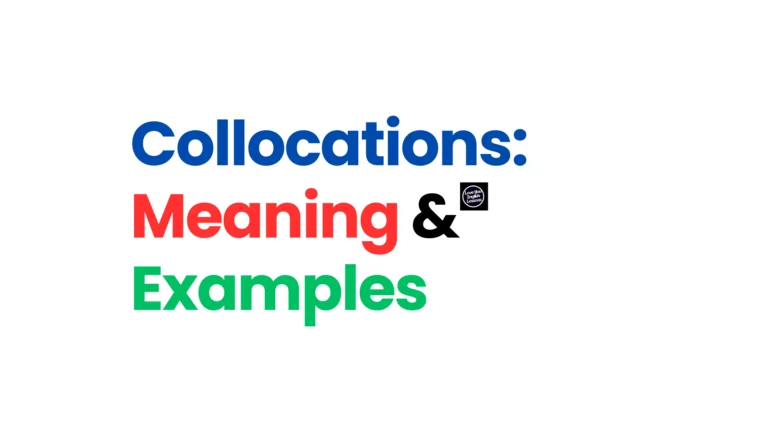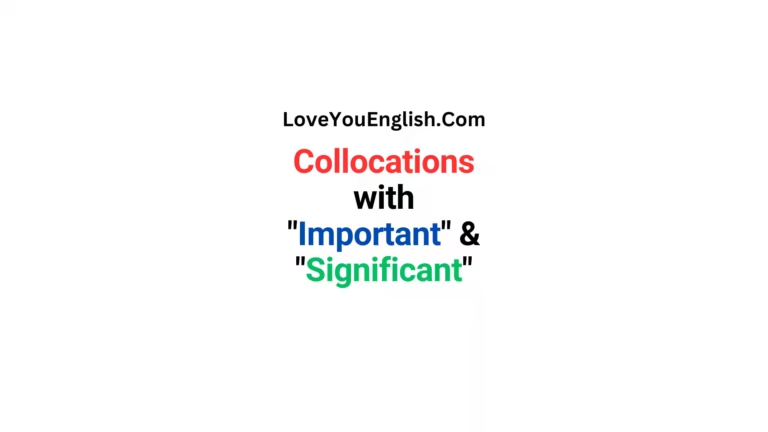English Collocations with Prepositions
Sharing is caring!
In English, certain words often come together naturally, forming combinations that sound correct to native speakers.
These combinations are called collocations.
Understanding and using collocations can make your speech and writing sound more fluent and natural.
One key aspect of collocations is how certain verbs, adjectives, and nouns combine with prepositions.
These are called collocations with prepositions.
If you are an English learner, mastering these collocations is essential to speaking like a native speaker.
In this post, I’ll tell you what collocations with prepositions are, why they are important, and provide a list of common examples to help you practice.
What Are Collocations with Prepositions?
Collocations are word combinations that frequently occur together.
They are natural and sound “right” to native speakers, even though they may not always make sense literally.
When prepositions are involved, these combinations become even more important.
Prepositions like in, on, at, to, and for can change the meaning of a verb or noun and form expressions that you need to learn and use correctly.
For example:
These combinations are not random. They follow patterns that learners need to understand to speak correctly.
Why Are Collocations with Prepositions Important?
Learning collocations with prepositions helps in many ways:
- Fluency and Natural Sounding English: If you use the right prepositions with verbs and adjectives, your English will sound more natural. This is because native speakers often use these combinations without thinking.
- Avoiding Mistakes: If you use the wrong preposition with a word, it might sound awkward or even incorrect. For example, we say good at something, not good in. Using incorrect prepositions can confuse listeners or readers.
- Improving Vocabulary: Understanding collocations helps you expand your vocabulary. Rather than just memorizing individual words, you learn how to use them in the right context.
- Better Communication: Prepositions are small words, but they carry a lot of meaning. Knowing which preposition to use with a verb or adjective allows you to express yourself clearly and more effectively.
Common Prepositions in Collocations
The most common prepositions in collocations are:
Each preposition has its own patterns of use, and understanding these patterns will help you use collocations naturally.
1. Collocations with “In”
The preposition “in” is used with many nouns, adjectives, and verbs. It often refers to a location or a state.
Examples:
- Interested in (I’m interested in learning new languages.)
- Believe in (Do you believe in magic?)
- Good in (She’s very good in math.)
- Rich in (This dish is rich in flavor.)
- Skilled in (He is skilled in programming.)
2. Collocations with “On”
“On” is used when something is placed on a surface or when referring to topics or activities.
Examples:
- Focus on (Please focus on your studies.)
- Rely on (I rely on my friends for support.)
- Work on (She is working on a new project.)
- Agree on (We need to agree on the time.)
- Impose on (Don’t impose on others.)
3. Collocations with “At”
“At” is used when referring to specific places, times, or activities.
Examples:
- Good at (He’s really good at playing soccer.)
- Arrive at (I will arrive at 5 PM.)
- Look at (Look at the beautiful painting.)
- Smile at (She smiled at me.)
- Surprised at (We were surprised at the news.)
4. Collocations with “For”
“For” is used to indicate purpose, time, or reason.
Examples:
- Apply for (I’m going to apply for the job.)
- Wait for (I am waiting for my friend.)
- Look for (I’m looking for my keys.)
- Ask for (She asked for a glass of water.)
- Famous for (Paris is famous for its Eiffel Tower.)
5. Collocations with “To”
“To” is often used to show direction, purpose, or relationships.
Examples:
- Go to (I am going to the market.)
- Listen to (He is listening to music.)
- Talk to (She is talking to her friend.)
- Introduce to (Let me introduce you to my colleague.)
- Relate to (I can relate to your situation.)
6. Collocations with “With”
“With” is used to express connection or relationship between people or things.
Examples:
- Agree with (I agree with your opinion.)
- Communicate with (She communicates with her team every day.)
- Play with (The children are playing with their toys.)
- Discuss with (I need to discuss this with my manager.)
- Fight with (They often fight with each other.)
Tips for Mastering Collocations with Prepositions
Here are some simple tips to help you master collocations with prepositions:
1. Practice Regularly
The more you practice, the better you will become at using the right prepositions. Try reading books, listening to podcasts, and watching TV shows or movies in English. Pay attention to how native speakers use prepositions in collocations.
2. Learn Prepositional Phrases
Prepositional phrases are groups of words that include a preposition and its object. For example, interested in, good at, or famous for are all prepositional phrases. Make a list of common phrases and practice them until they become part of your vocabulary.
3. Use Collocations in Conversations
Once you learn a few collocations, use them in your daily conversations. Try to say them naturally in context. This will help you remember them better and improve your fluency.
4. Use a Dictionary or Online Resources
If you are unsure about which preposition goes with a word, use a good dictionary. Many online resources, including websites and apps, can help you with common collocations. You can also search for collocation dictionaries or lists.
5. Listen and Mimic Native Speakers
Listen to how native speakers use prepositions in collocations. Try to mimic their sentences and pronunciation. This will help you develop a natural way of speaking.
6. Take Notes
Write down new collocations with prepositions as you learn them. Review your notes regularly to reinforce your knowledge. Over time, these will become automatic.
Conclusion
Mastering collocations with prepositions is an essential step toward becoming fluent in English.
By understanding the common patterns and practicing regularly, you can sound more like a native speaker and avoid making mistakes.
Remember, collocations are not about memorizing individual words but learning how they naturally combine with prepositions.
With time and practice, you will be able to use these combinations confidently, making your English sound smoother and more accurate.
So, start incorporating collocations with prepositions into your daily conversations, and you’ll soon notice improvements in your language skills.
Happy learning!
Sharing is caring!







